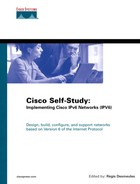History of IPv6
Demonstration of the IP address space exhaustion led to the consensus that there was enough time to design, engineer, and test a new protocol with enhanced functionalities instead of deploying a new protocol that just adds larger addresses. This represented a unique opportunity to fix the limitations related to the IPv4 addressing scheme and to develop a protocol to ensure reliable growth of the Internet over the next decades. The process took care of requirements from various industries, including the cable and wireless industries, electric power utilities, the military, corporate networks, Internet service providers (ISPs), and many others.
In 1993, a call for proposals (RFC 1550) was issued. Three were studied in detail:
Common Architecture for the Internet (CATNIP) proposed converging the CLNP, IP, and IPX protocols with the use of Network Service Access Point (NSAP) addresses. (Defined in RFC 1707.)
Simple Internet Protocol Plus (SIPP) proposed increasing the IP address size to 64 bits and improving the IP header. (Defined in RFC 1752.)
TCP/UDP Over CLNP-Addressed Networks (TUBA) suggested replacing IP (Layer 3) with Connectionless Network Protocol (CLNP), where TCP/UDP and other upper protocols could run on top of CLNP. (Defined in RFC 1347.)
The recommended proposal was SIPP, with an address size of 128 bits. The main author of SIPP was Steve Deering. IANA assigned the version number 6 to the protocol. A working group at IETF called IP Next Generation (IPng) was started in 1993 just before the web really led to the explosion of Internet traffic. However, the issue of IPv4 existed before the web. Then, the first specifications came in late 1995 (RFC 1883). The IPng working group was renamed IPv6 in 2001. Figure 1-3 shows the origin and evolution of IPv6.
Figure 1-3. History of IPv6

In 1996, an IPv6 test bed called the IPv6 backbone (6bone) was created over the Internet. The 6bone has used mainly a mix of Cisco IOS Software routers with IPv6 beta implementations and other router software under UNIX platforms. IPv6 prefixes within the IPv6 space 3ffe::/16 were assigned to the 6bone participants. In 1997, a first attempt was made to structure the IPv6 space as a provider-based IPv6 address format. One year later, the first IPv6 exchange, called 6TAP, was deployed at STARTAP in Chicago. In 1999, regional Internet registries (RIRs) started assigning production IPv6 prefixes using the IPv6 space 2001::/16. In the same year, the IPv6Forum, a worldwide consortium of leading Internet vendors and research and education networks, was founded to promote IPv6 in the market and to enable collaboration between vendors. In 2000, many vendors began bundling IPv6 into their mainstream products. Cisco introduced a three-phase road map for the development of IPv6 and made IPv6 support available in Cisco IOS Software Release 12.2(2)T. In 2001, Microsoft announced the availability of IPv6 in the mainstream code of its latest operating system, Windows XP.
NOTE
Chapter 7, “Connecting to the IPv6 Internet,” provides detailed information about the 6bone and the IPv6 spaces assigned by IANA. Chapter 6, “IPv6 Hosts Internetworking with Cisco,” describes the IPv6 support on Microsoft Windows XP.
